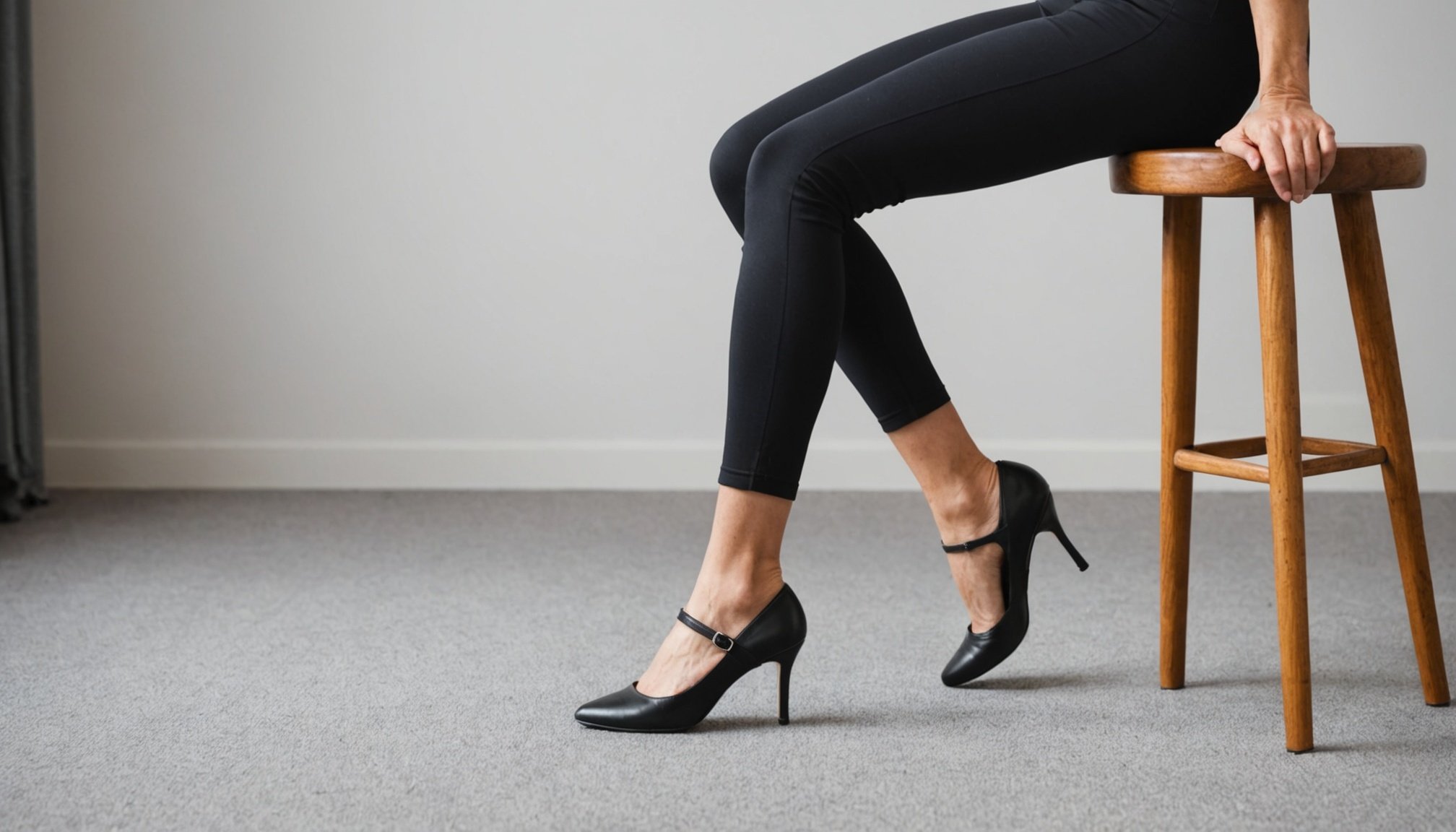Discover the Top 3 Strengthening Exercises to Boost Ankle Stability for High Heel Enthusiasts
For many, high heels are a staple in their wardrobe, adding a touch of elegance and confidence to any outfit. However, the allure of high heels often comes with a price: compromised ankle stability and increased risk of injury. If you’re a high heel enthusiast, it’s crucial to incorporate exercises that strengthen your ankles to prevent pain and ensure long-term mobility. Here are the top 3 strengthening exercises to help you achieve better ankle stability.
Understanding the Importance of Ankle Stability
Before diving into the exercises, it’s essential to understand why ankle stability is so critical, especially for those who frequently wear high heels.
Also read : How can you explore fashion from different cultures while respecting their origins?
Ankle stability is the ability of the ankle joint to withstand various forces and movements without succumbing to injury. High heels alter the natural alignment of the foot and ankle, placing additional stress on the ankle joint and surrounding muscles. This can lead to a range of issues, including ankle sprains, chronic pain, and reduced mobility.
“High heels can significantly affect the biomechanics of the foot-ankle complex, making it more prone to injuries,” notes Dr. Jane Smith, an orthopedic specialist. “Strengthening the muscles around the ankle is key to mitigating these risks.”
Also to read : How can you incorporate statement jewelry into your outfits without overwhelming them?
Exercise 1: Calf Raises
Why Calf Raises?
Calf raises are a powerful exercise for strengthening the muscles around the ankle, particularly the gastrocnemius and soleus muscles, which are crucial for ankle stability.
How to Perform Calf Raises
- Starting Position: Stand on a flat surface with your feet shoulder-width apart.
- Motion: Slowly rise onto your toes, keeping your knees straight, and hold for a few seconds.
- Return: Lower your heels back to the starting position.
- Repetitions: Perform 3 sets of 15-20 repetitions.
Tips and Variations
- Single-Leg Calf Raises: For added challenge, perform calf raises on one leg. This will also improve balance and stability.
- Using a Resistance Band: You can use a resistance band to add extra resistance to your calf raises, further strengthening the muscles.
| Exercise | Sets | Repetitions | Tips |
|
|------|
|---------------------------------------|
| Calf Raises | 3 | 15-20 | Stand on a flat surface, feet shoulder-width apart. |
| Single-Leg Calf Raises | 3 | 10-15 | Perform on one leg to improve balance and stability. |
| Calf Raises with Resistance Band | 3 | 10-15 | Add extra resistance for increased muscle strength. |
Exercise 2: Single-Leg Balance
Why Single-Leg Balance?
Single-leg balance exercises target the smaller stabilizer muscles around the ankle joint, enhancing overall stability and reducing the risk of ankle sprains.
How to Perform Single-Leg Balance
- Starting Position: Stand on one leg, keeping the other foot lifted off the ground.
- Balance: Hold this position for 30 seconds to 1 minute.
- Repetitions: Perform 3 sets on each leg.
Tips and Variations
- Eyes Open vs. Eyes Closed: Start with your eyes open and gradually move to eyes closed to increase the challenge.
- Using a Support: If you’re new to single-leg balance, use a wall or chair for support until you build enough stability.
| Exercise | Sets | Duration | Tips |
|
|------|
|---------------------------------------|
| Single-Leg Balance | 3 | 30 seconds to 1 minute | Start with eyes open, gradually move to eyes closed. |
| Single-Leg Balance with Support | 3 | 30 seconds to 1 minute | Use a wall or chair for support if needed. |
Exercise 3: Ankle Dorsiflexion with a Resistance Band
Why Ankle Dorsiflexion?
Ankle dorsiflexion exercises focus on the flexor muscles of the foot, such as the flexor hallucis longus and flexor digitorum longus, which are essential for maintaining proper ankle mobility and stability.
How to Perform Ankle Dorsiflexion with a Resistance Band
- Starting Position: Sit on the floor with your legs straight out in front of you. Loop a resistance band around the ball of your foot.
- Motion: Pull your toes back towards your shin, keeping your knee straight, and hold for a few seconds.
- Return: Slowly return to the starting position.
- Repetitions: Perform 3 sets of 10-15 repetitions on each foot.
Tips and Variations
- Adjusting Resistance: Adjust the tension of the resistance band based on your comfort level.
- Combining with Toe Flexion: Incorporate toe flexion exercises to target the metatarsophalangeal joints (MTPj) flexors, further enhancing ankle stability.
| Exercise | Sets | Repetitions | Tips |
|
|------|
|---------------------------------------|
| Ankle Dorsiflexion with Resistance Band | 3 | 10-15 | Adjust the tension of the resistance band as needed. |
| Ankle Dorsiflexion with Toe Flexion | 3 | 10-15 | Incorporate toe flexion to target MTPj flexors. |
Practical Insights and Actionable Advice
Preventing Ankle Sprains
Ankle sprains are a common issue for high heel wearers. Here are some tips to prevent them:
- Warm-Up and Cool-Down: Always warm up before wearing high heels and cool down afterwards with some light stretching.
- Strengthening the Achilles Tendon: The Achilles tendon plays a crucial role in ankle stability. Incorporate exercises like heel raises to strengthen it.
- Proper Footwear: Choose high heels with a wider base for better stability and consider orthotics or shoe inserts for additional support.
Managing Pain
If you experience pain after wearing high heels, here are some steps to manage it:
- Rest and Ice: Give your ankles a break and apply ice to reduce inflammation.
- Stretching: Perform gentle stretches to improve ankle mobility and reduce stiffness.
- Consult a Professional: If the pain persists, consult an orthopedic specialist for personalized advice.
Maintaining strong and stable ankles is paramount for high heel enthusiasts. By incorporating these top 3 strengthening exercises into your routine, you can significantly reduce the risk of injury, improve your overall mobility, and enjoy wearing your favorite high heels with confidence.
As Dr. Jane Smith advises, “Consistency is key. Make these exercises a part of your weekly routine, and you’ll see a noticeable improvement in your ankle stability over time.”
So, the next time you slip into your high heels, remember that a little extra effort in strengthening your ankles can go a long way in ensuring you stay pain-free and stylish.











